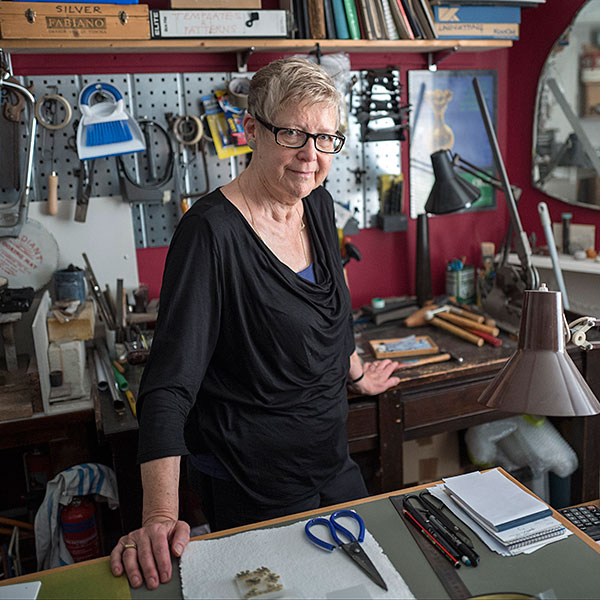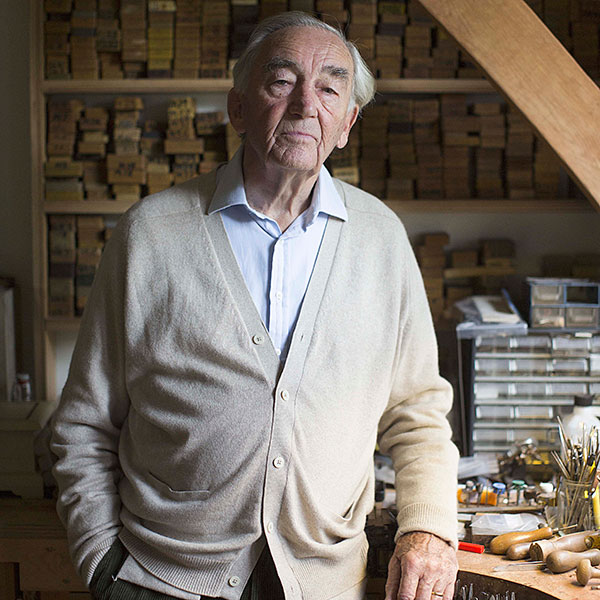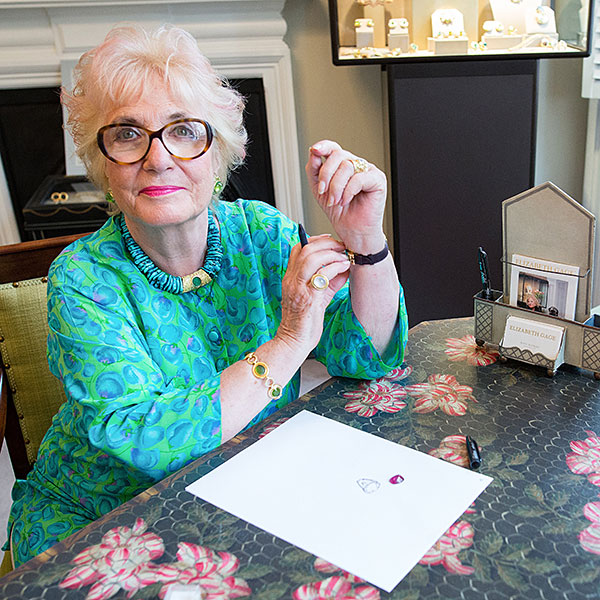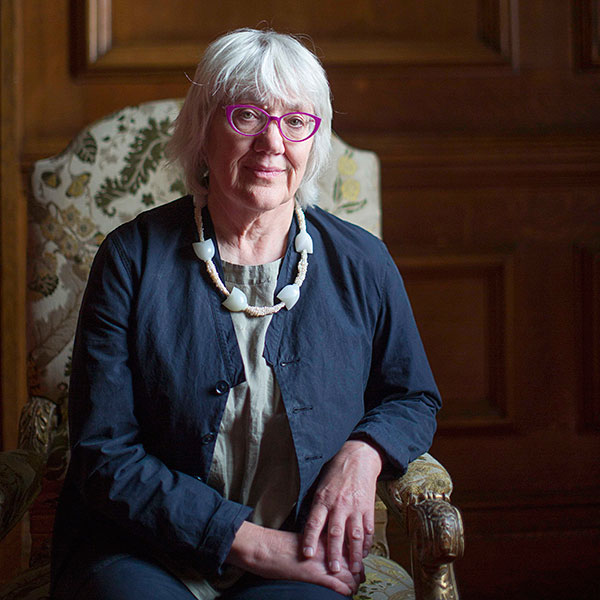Post-war jewellers like John Donald and Elizabeth Gage still work
Roula Khalaf, Editor of the FT, selects her favourite stories in this weekly newsletter.
Ask a jeweller of a certain age about a career-defining moment and they may well tell you about the International Exhibition of Modern Jewellery of 1961.
Held at London’s Goldsmiths’ Hall, the exhibition of nearly 1,000 jewels from 33 countries showed new designs from international houses such as Harry Winston and Cartier, but it also showcased avant-garde jewellery. There were pieces by artists including Picasso, Salvador Dalí and René Lalique, as well as specially commissioned items by modern artists like Henry Moore.
For many budding designers, uninspired by the jewellery of the postwar era, it was a moment of revelation. And some of the jewellers who were young then are still working today, in their seventies and eighties.
“It influenced everybody,” says Jacqueline Mina, who was reluctantly studying jewellery at the Royal College of Art at the time: she had been denied a place due to her gender on what she considered to be the worthier silversmithing course.
“I saw the work of René Lalique and I was overtaken by that,” she says. “It wasn’t an influence, as I don’t work in his style, but[it was important] just to see what could be done with jewellery, having thought it was more like what you saw on the high street, which in the 1960s was very traditional and conservative. That exhibition showed me what jewellery could be.”

That first taste of innovation won over Ms Mina, and her quest for novelty in jewellery design has not ceased since. The 74-year-old’s latest experiment is a new collection called Alleoritic, which fuses gold and platinum together and will be launched at the Scottish Gallery during next year’s Edinburgh Festival.
Also included in the International Exhibition were renegade young designers such as John Donald. He became famous as a society jeweller in the Swinging Sixties, when his bold artistic jewels and brooches upstaged the mundane faux-Art Deco and Victorian styles which dominated postwar British taste. He won the patronage of posh London figures, including Princess Margaret and the Queen Mother, and still produces jewellery today.
The start of his career in the 1950s coincided with a moment of great experimentation, rule-breaking and creativity which was the origin of contemporary jewellery. “When I started in the mid-to-late 1950s, there were very few new things being made in jewellery,” he says. “Innovation just hadn’t happened for 20 years, partly because of the war, so in design terms one could do anything at all. It was a completely open book. I think if there had been any real movement before that, it might have been more difficult.”

The cultural revolution in British taste of the 1960s did not escape jewellery: a whole generation of jewellers was imbued with a freedom to pursue a singular style not influenced by the past. Precious metals and gems were then cheaply obtained, and teaching one day a week covered their rent, which allowed them to design not for commerce but for their own creative satisfaction. They lived what some of them describe as hand-to-mouth existences in bedrooms that doubled as workshops, or packed together into cheap studios. It was the Romantic vision of the struggling artist, but with soldering and setting, not brush strokes and canvas.
“When I first started out, I never thought way into the future, I just knew I had to get on and do it because I loved it so,” says jeweller Elizabeth Gage, who does not disclose her age. Instead, she describes age as “a number — and mine is unlisted”. A 2015 retrospective of her career at the New Britain Museum of American Art in Connecticut charted her work back half a century. “You must listen to your own feelings about what you do and love what you do, because without loving your work you don’t get great results.”
Ms Gage, who is gearing up to present her latest collection of jewels in New York in November, says that even after 50 years of work, she still takes pleasure in sitting down with a client to plan out a new commission. “I don’t think I will ever retire,” she says. “It is my joy of doing something new that keeps me going.”

. . .
For many jewellers plying their trade beyond the traditional retirement age, the decision to do so can be one fuelled not by passion alone but by financial necessity. “Most of us haven’t got pensions,” laughs Charlotte De Syllas, when asked what keeps so many jewellers at the bench in their later years. Ms De Syllas, whose speciality is bespoke gemstones elaborately carved by hand, turned 70 this year, which she marked with a three-month retrospective at the Goldsmiths’ Hall recounting five decades in the trade. Despite a celebrated career, she says she has struggled financially due to an inability to “count the pennies”.
“Lots of people in the craft world work beyond retirement, partly because they love doing it, and partly because financially you’re not paid regularly, so you go on until you get fed up with it or you’re too tired to do it,” says Ms De Syllas, who is working and teaching at her studio in Norwich. “Most of the people I know who are my age are still working. Some have cut down a bit, potters especially as it’s much more physical.”

Because of its small scale, jewellery-making carries its own physical demands. The detailed nature of the work can be taxing on eyes and hands which do not get any more agile as time passes. “I don’t do the close work any more, although I have had my eyes adjusted,” says John Donald, who now makes models of his designs in wax at home in Sussex and sends them to be cast in gold in London. Ms Gage, too, has vastly reduced the amount of benchwork she does, preferring to design.
Despite having slight arthritis in her hands, Ms Mina is yet to make compromises to her method of working, even though it calls for a manual blowtorch. “It is beginning to get a little bit hard,” admits the London-based jeweller, who in 2012 was awarded an OBE for services to art. “I use my own breath when I’m soldering or fusing, and my lungs aren’t as good as they used to be.”
While age can throw up trials for jewellery-makers, it can also unlock freedoms. With established careers, many jewellers of this generation no longer feel the pressure to prove themselves. “When I was young, I almost felt I was ruled by demons pushing me to work more, to be more creative, to express more, to make my ideas into reality,” says Björn Weckström, an 81-year-old artist who has spent 50 years designing space-age jewellery for Finnish brand Lapponia and was shown at the International Exhibition in 1961. “As I have gotten older, the fortunate thing is that there is no longer that push. You can be creative without timeframes.”
With the pressure reduced, anything these jewellers make now is a bonus, returning to them that sense of creative freedom they lost as the wild student days of the 1950s and 1960s gave way to balancing the books and the demands of clients.
These jewellers have seen — and survived — five decades or more, which is why many of them are sought after as speakers at events organised for the next generation of jewellers. Some have even written books about their careers — Mr Donald published his memoir Precious Statements last year and it charts, among other highs, his escape from the 1970s British recession, which he achieved by filling a suitcase with jewels and jetting off to Kuwait, a lucrative market that was then uncharted by British jewellers.
While their original customer base has aged, the enduring appeal of their work has won younger fans, sometimes grandchildren inheriting original works who want them modified to modern tastes — a new market that is keeping Mr Donald busy.
Comments